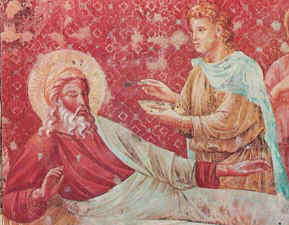|
|
Storia dell'arte - Story of Art
|
|
|
GIOTTO OF BONDONE – PAINTER, ARCHITECT, SCULPTOR
Florentine Artist during 1266-1337 surrounded with mythic episodes, many of which had historical evidences in reality, thanks to profound researches and studies carried on by many other very reliable artists, among whom Vasari, therefore he doubtless had been a pupil under Maestro Cimabue. Among the frescos the representation of the San Francesco’s Life in the superior church of his basilica probably done during the last years in thirteenth century. Further exterior evidences of his paternity of the fresco are represented on a board with the San Francesco’s Stigmate where some of the frescos are reproduced even if with some changes, which is located at the Louvre Museum in Paris. In case this board was not personally painted by Giotto it at least provides on more evidence it belongs to his school. After learning and mastering what his direct teachers, and those belonging to the past taught him, and also after being "contaminated" by the Roman school, he started proclaiming his new and sour (because of his young age) art and, later, he softened it . In Assisi at the superior church of San Francesco, also the last frescos about the story of the Old and New Testament are considered done by him. Unfortunately we know very little about the period between the frescos done in Assisi and those done in Padova. In 1300 the Pope called him to Rome. There are some anecdotes about how the Vasari was astonished after seeing with what natural ability Giotto would have drawn, by hand without any instrument to be precise but only using a brush dipped in the red ink, the famous circle which has become a myth in Art History from then on. In Rome he left, at the Vatican, two Angels of the mosaic of the "Navicella" and at "San Giovanni in Laterano" church the fresco with Bonifacio VIII who is proclaiming the Jubilee where Giotto begins to soften his primitive sourness by searching for a gradual fusion in shades and lights. Also the crucifix of S. Maria Novella in Florence and the big icona of the Madonna at the Uffizi, masterpieces of the same period, are attributed to him. Also belong to him, in Padova, at the Cappella degli Scrovegni 37 stories of the Madonna del Redentore and the Final Judgement. In all of his latest works, his use of prospective is masterly as well as his way in representing spirituality and drama in his works: the slaughter of the innocents, "Noli me tangere", the escape to Egypt; the sleeping of the Madonna at the Museum in Berlin. He spent his last 30 years in Naples, Florence and Milan while increasing his production thanks to his pupils who became more and more. Works dating back to this period are in the Bologna Art Gallery, at Santa Croce Art Gallery in Florence and at the Vatican one in Rome. In addition, it is sure that the frescos of the cappella Bardi in Santa Croce and of the cappella Peruzzi in Florence, city where he also was "Capomastro" of S. Maria del Fiore of which he also started drawing a project for the bell tower which might have been completed by Andrea Pisano. In his artistic expression the conscience of human reality prevails wile opposing the gothic, rich dispersive taste in order to give more value to the intimate need for the essential things. In such a way he is proposing once again to the Western World the superiority of the human creatures through their spiritual and Christian experiences. This value had already been respected in the classic art and it develops and glorifies itself during Renaissance years.
|
|
|
